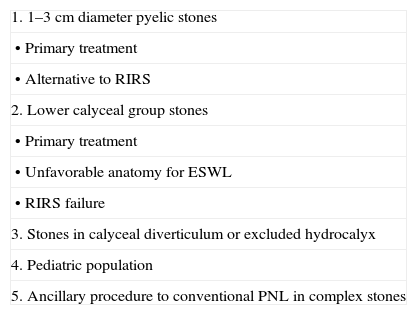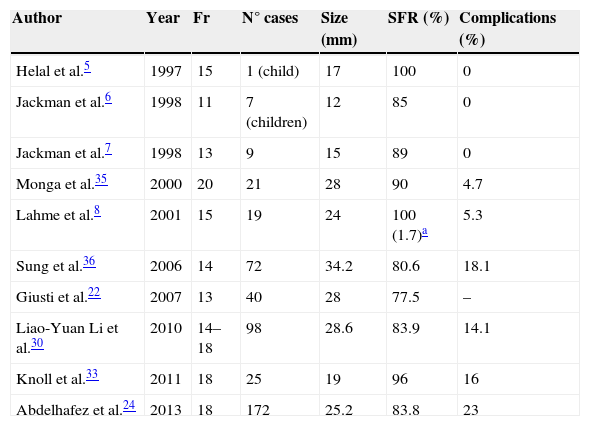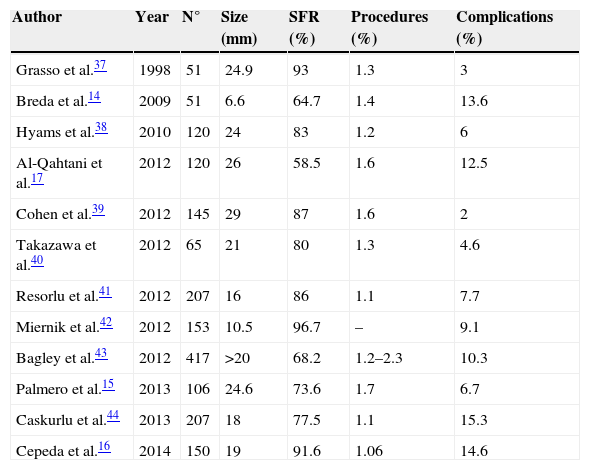Extracorporeal shock wave lithotripsy (ESWL) and percutaneous nephrolithotomy (PCNL) are consolidated procedures for the treatment of kidney stones; however, their primary weak points are the lower efficacy of ESWL, especially for lower calyx stones, and the morbidity of PCNL resulting from the creation and dilation of the percutaneous trajectory. The increasing miniaturization of percutaneous surgery instrumentation and the development of retrograde intrarenal surgery (RIRS) are recent innovations.
Acquisition of evidenceA structured nonsystematic review was conducted through a literature search of articles published between 1997 and 2013, using the terms kidney stones, miniperc, mini-PCNL, RIRS and flexible ureteroscopy in the PubMed, Google Scholar and Scopus databases.
Summary of the evidenceRIRS requires greater surgical time, several procedures for voluminous stones and higher hospital costs, due in part to the relative fragility of the instruments. On the other hand, miniperc requires a longer hospital stay, an increased need for postoperative analgesia and a greater reduction in hemoglobin levels, although these do not translate into an increased rate of transfusions.
ConclusionsThe current treatment of kidney stones uses minimally invasive procedures such as miniperc and RIRS. The two procedures are equivalent in terms of efficacy (stone clearance) and are associated with minimal complications. Comparative prospective studies are necessary to determine the position of each of these techniques in the treatment of kidney stones. In our experience, the two techniques are complementary and should be part of the current urological therapeutic arsenal.
La Litotricia Extracorpórea por Ondas de Choque (LEOCH) y la Nefrolitotomía Percutánea (NLP) son procedimientos consolidados en el tratamiento de la litiasis renal, pero sus principales puntos débiles son la menor eficacia de la LEOCH, especialmente en litiasis de cáliz inferior, y la morbilidad de la NLP, derivada de la creación-dilatación del trayecto percutáneo. La creciente miniaturización del instrumental de cirugía percutánea, y el desarrollo de la cirugía retrógrada intrarrenal (CRIR) son innovaciones recientes.
Adquisición de evidenciaSe ha llevado a cabo una revisión estructurada no sistemática, a través de una búsqueda bibliográfica de los artículos publicados entre 1997 y 2013, utilizando los términos litiasis renal, miniperc, mini-NLP, CRIR y ureteroscopia flexible en las bases de datos PubMed, Google Scholar y Scopus.
Síntesis de evidenciaLa CRIR consume mayor tiempo operatorio, precisa varios procedimientos en litiasis voluminosas e implica mayor coste hospitalario, derivado en parte de la relativa fragilidad del instrumental. Por otro lado, miniperc, precisa una estancia hospitalaria más prolongada, mayor necesidad de analgesia postoperatoria y mayor descenso de hemoglobina, aunque sin traducirse en una mayor tasa de transfusión.
ConclusionesEl tratamiento contemporáneo de la litiasis renal emplea procedimientos mínimamente invasivos como miniperc y CRIR. Ambos son equivalentes en términos de eficacia (aclaramiento litiásico) y se asocian con mínimas complicaciones. Son necesarios estudios comparativos prospectivos que determinen la posición de cada una de estas técnicas en el tratamiento de la litiasis renal. En nuestra experiencia ambas resultan complementarias y deben formar parte del arsenal terapéutico actual urológico.















